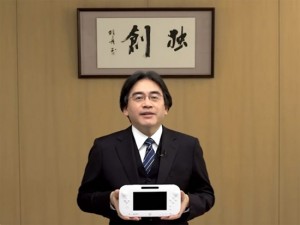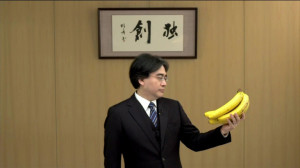
Satoru Iwata during one of his Nintendo Direct webshows that he made a staple of the company’s outreach strategy.
I had recently added a few names to my browser’s spellcheck because of how regularly I need to type them in these articles and elsewhere: Miyamoto, Hideo, Miyazaki, Sakurai, Iwata. I had only just done this, getting sick of the little red line that would show up under these names I invoked so often. To the wider world these names mean little, and so they are not a part of the small lexicon of Japanese names my software already knows about like Yamamoto. But to readers of this site, these names are some of the biggest out there today. When I mentioned the untimely death of Satoru Iwata to relatives or coworkers or even some friends, it was only after explaining who he was and how young he was before I would get reactions approaching dismay, and I expected as much. But when I read the headline for the first time I stopped everything. I was getting ready to leave for work. I showed up late that day.
There are already several pieces composed elsewhere that do a better and more timely job of recapturing the initial moments reacting to this tragic news and I think the time to share those experiences, at least for me, has passed. There are also plenty of articles detailing the many past achievements of Mr. Iwata as he built himself up from a simple but hardworking programmer to a man being groomed by the intimidating Hiroshi Yamauchi to be the next company president. Instead of trying to add to that, I would like to take a look back at the transitioning years of Nintendo as it changed hands from Yamauchi to Iwata during the early to middle days of the GameCube and at the following transitional phase Nintendo sees itself in today.
As Iwata took his position as president, the company’s home console business was troubled and their highly successful handheld business was being threatened by a growing Sony currently experiencing the success of the indomitable PS2. Nintendo was in a rough place, and Iwata had inherited the honor of deciding where to go in a pivotal moment. The DS was doubtless long in the pre-planning stages before its initial release in 2004, but it was up to Iwata to navigate the waters of introducing the public to this very unorthodox device while Sony was beating the drums of what appeared to be Nintendo’s biggest threat yet to their handheld dominance with the PSP. Iwata was immediately tested with these events, making the cautious decision to introduce the DS not necessarily as a replacement for the GameBoy line, but as a “third pillar” solution. Time would confirm the PR spin behind that rhetoric, but not before Iwata would appoint the (in)famous Reggie Fils-Aimé to introduce the system as Nintendo of America’s new VP of Sales.
Fils-Aimé, among other things, promised to “kick ass and take names” in a stunt to grab the attention of hardcore gamers and have them take another look at the Nintendo platform. But this strategy of appealing to M-rated players would not last long under Iwata as the last gasps of reclaiming that group from Sony would fall away to doubling down on the more historically representative qualities of Nintendo. With creators like Shigeru Miyamoto and Masahiro Sakurai in tow, Iwata clearly decided to adjust the company to be more inline with their most successful output. The Legend of Zelda: Twilight Princess would prove to be the last vestige of reaching out to the demands of a particular set of gamers, instead Iwata would focus on efforts like Wind Waker and steer the company in a direction that matched the spirit of his fellow game developers.
The Wii sought to rekindle a family friendly environment with a great deal of emphasis being placed on newer players of all ages, and the germ of the idea was a brilliant move. As Sony and Microsoft entrenched themselves into a war over graphical fidelity and the attention of the 18 to 20-something demographic, Iwata found a solution to not being able to produce the same weaponry as its competition, and that was to change the weapon they were using entirely. This weapon did not even target the same people, it did not use the same ammo, and the result for a time was an uncontested battlefield where Nintendo was the only one around. As much as they talked about their blue ocean strategy, I never found that messaging to be honest as their competitors would make regular attempts to jump on Nintendo’s successes with non-traditional control schemes. But what everyone probably did not expect was that this well was destined to run dry, even before the Wii’s generation officially ended.
The people that proved good targets for the Wii were all largely one-offs, not even content to support the system very long after launch. The console sustained itself for a while on new system sales as more and more relatives of Wii owners discovered the device and bought one for their own and as gifts for practically everyone they knew. The price was right and it was not the same as those other videogames with the violence and the complicated controllers. This one was a very Apple-eqsue white, with simple TV remote input methods and a try-it-for-yourself gimmick of motion controls. The Wii would prove to be a lot more like an “As Seen on TV” console than any that came before it or any that have come since, and it would be both blessed and cursed to attract “As Seen on TV” consumers. For anyone who knows about that particular selling strategy, they would know those products sell well only for a time before the novelty wears off.
And Iwata sensed this, much to his credit, as the Wii U made several steps to re-enter the more traditional games space that had been exited with the Wii. The problem was that a reception to this half-measure was a confused and disinterested buying public, the cache of the name “Wii” had not only been spent, it had been burnt, and this console would mistakenly keep that name alive. And so the company entered yet another dire and pivotal moment in its history, once again with its back up against a wall. Iwata needed to pull out the fast thinking that got him out of this kind of situation before. The only problem is he would not live to see the full arc of his plans come to light. For a company like Nintendo, which has only changed leadership four times in over one hundred years, any sudden moves belie a great need so to do. With big moves involving the once-disavowed mobile market and partnerships with DeNA, with discussions of branching out beyond just a games business, Iwata was in the midst of yet again reshaping Nintendo.
His loss means we will not know for certain how he would have carried out this transition, and the tragedy of his untimely passing is only compounded by an absence of leadership at an absolutely critical juncture. Nintendo has been in these troubled waters before, and historically they have been lead through to amazing things not only for the company but for the world at large. Today it sits adrift in these waters–and we with them–its sail suddenly blown loose to the wind.

